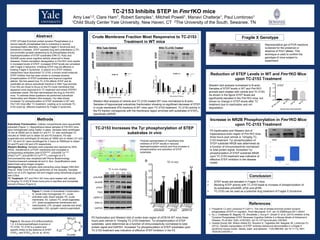
YALE POSTER presentation (3)
- 1. TC-2153 Inhibits STEP in Fmr1KO mice Amy Lee1,2, Clare Ham1, Robert Samples1, Mitchell Powell1, Manavi Chatterje1, Paul Lombroso1 1Child Study Center Yale University, New Haven, CT 2The University of the South, Sewanee, TN STEP (STriatal-Enriched protein tyrosine Phosphatase) is a neuron-specific phosphatase that is overactive in several neuropsychiatric disorders, including Fragile X Syndrome and Alzheimer’s Disease. STEP opposes long term potentiation (LTP) and promotes synaptic weakening by its phosphatase activity. Dephosphorylation of STEP substrates ERK1/2, Pyk2 and GluN2B cause some cognitive deficits observed in these diseases. Protein translation disregulation in Fmr1KO mice results in increased levels of STEP; increased STEP levels are correlated with Fragile X behaviors. Inhibiting STEP may be effective in treating Fragile X Syndrome. In search of a STEP inhibitor, researchers have discovered TC-2153; a known small-molecule STEP inhibitor that has been shown to increase tyrosine phosphorylation of STEP substrates and improve cognitive deficits. We first asked how TC-2153 affects STEP and its substrates at various subcellular fractions in Wild Type animals. From this we chose to focus on the P2 crude membrane that appeared most responsive to TC treatment and where STEP61 substrates reside. We then administered the drug to Fmr1KO mice. To address these questions we performed subcellular fractionation and Western Blot analysis. Our data shows increased Tyr phosphorylation of STEP stubstrate in WT and Fmr1 KO mice after TC treatment. Leading us to conclude TC- 2153 could be effective treatment for Fragile X syndrome. Crude Membrane Fraction Most Responsive to TC-2153 Treatment in WT mice Fragile X Genotype Conclusion Subcellular Fractionation: Cellular compartments were sequentially extracted (Figure 1). Hippocampus tissue samples of Fmr1KO mice were homogenized using Tepfon in glass. Samples were centrifuged 10 min at 28000 rpm to obtain S1 and P1. S1 was centrifuged 15 minutes at 10400 rpm to obtain S2 and P2 fractions. P2 was suspended and centrifuged 20 minutes at 18000 rpm to obtain LS1 and LP1. S2 and LS1 were centrifuged for 2 hours at 70000rpm to obtain S3 and P3 and LS2 and LP2 respectively. Western Blotting: Samples were prepared and resolved by SDS- PAGE, transferred to a PVDF membrane and incubated in corresponding antibodies (anti-STEP23E5, pGluN2B:Tyr1472, pPyk2:Tyr402, and pERK1/2:Tyr204/187), overnight at 4°C . Immunoreactivity was visualized with Pierce Biotechnology Chemiluminescent substrate kit and G: Box. Quantifications were determined using ImageJ program. Genotyping: DNA samples were extracting using Qiagen DNA Mini Prep kit. Real-Time PCR was performed on the samples. Samples were run on a 2% Agarose Gel and imaged using GeneSnap program with G:Box. TC Treatment: WT and Fmr1 KO mice were treated with vehicle or10mg/kg TC-2153 IP three hours prior to sacrifice and immediate harvest of tissue (Figure 2). Figure 1: Levels of Subcellular Fractionation. H, whole brain homogenate; P1, nuclei, unbroken cells, blood vessels; P2, crude membrane; S3, cytosol; P3, small organelles; LP1, lysed synaptosomal membranes and mitochondria; LP2, synaptic vesicles and small organelles; LS2, synaptic vesicle supernatant. Western Blot analysis of vehicle and TC-2153 treated WT mice normalized to B-actin. Samples of hippocampal subcellular fractionation showing no significant decrease of STEP in crude membrane (P2) fractions of WT mice upon TC-2153 treatment. TC-2153 activity in the P2 fraction corresponds with the membrane region enriched with substrates of STEP61 specifically pNR2B.. TC-2153 Increases the Tyr phosphorylation of STEP substrates in vivo P2 fractionation and Western blot of cortex brain region of c57B1/6 WT mice three hours post vehicle or 10mg/kg TC-2153 treatment. Tyr phosphorylation of STEP substrates were determined as a function of immunoreactivity normalized to total protein signal and GAPDH. Increased Tyr phosphorylation of STEP substrates upon TC-2153 treatment was indicative of effective STEP inhibition in the P2. Representative gel of PCR reactions screened for the presence or absence of Fmr1 alleles. This technique is used to confirm the genotype of mice subject to experiment. Western blot analysis normalized to B-actin. Samples of STEP levels in WT and Fmr1KO animals each treated with vehicle and TC-2153. As shown in the figure STEP levels are significantly elevated in the Fmr1KO mice, but shows no change in STEP levels after TC treatment due to inactivation and not degradation. STEP levels are elevated in Fragile X mice. Blocking STEP activity with TC-2153 leads to increase of phosphorylation of its substrates pGluN2B, pPyk and pERK. TC-2153 can be used as a potential drug treatment of Fragile X Syndrome Abstract Methods Figure 2: Structure of 8-(trifluoromethyl)- 1,2, 4,5-benzopentathiepin-6-amine or TC-2153. TC-2153 is a potent and specific inhitor to the isoforms of STEP: STEP61 and STEP46 (Xu et. al, 2014). Wild Type Vehicle Wild TC-2153 Treated STEP STEP pNR2B pNR2B Pictorial representation of hypothesis that inhibition of STEP results in reduced dephosphorylation activity and thus increase in phosphorylation and activation of STEP substrates. References Fitzpatrick CJ and Lomproso PJ (2011). The role of striatal-enriched protein tyrosine phosphatase (STEP) in cognition. Front Neuroanat. 5:47. dio:10.3389/fnana.2011.00047. Xu J, Chatterjee M, Baguley TD, Brouillette J, Kurup P, Ghosh D, et al. (2014) Inhibitor of the Tyrosine Phosphatase STEP Reverses Cognitive Deficits in a Mouse Model of Alzheimer's Disease. PLoS Biol 12(8): e1001923. doi:10.1371/journal.pbio.1001923 Goebel-Goody SM, Wilson-Wallis ED, Royston S, Tagliatela SM, Naegele JR, Lombroso PJ (2012). Genetic manipulation of STEP reverses behavioral abnormalities in a fragile X syndrome mouse model. Genes, brain, and behavior. 11(5):586-600. doi:10.1111/j.1601- 183X/2012/00781.x Reduction of STEP Levels in WT and Fmr1KO Mice upon TC-2153 Treatment STEP Increase in NR2B Phosphorylation in Fmr1KO Mice upon TC-2153 Treatment P2 fractionation and Western blot of hippocampus brain region of Fmr1KO mice three hours post vehicle or 10mg/kg TC- 2153 treatment. Tyr phosphorylation of STEP substrate NR2B was determined as a function of immunoreactivity normalized to total protein signal. Increased Tyr phosphorylation of STEP substrate NR2B upon TC-2153 treatment was indicative of effective STEP inhibition in the disease model. pNR2B